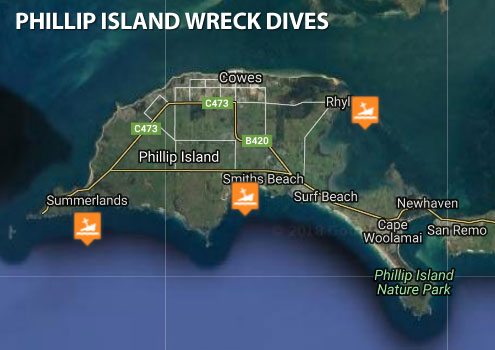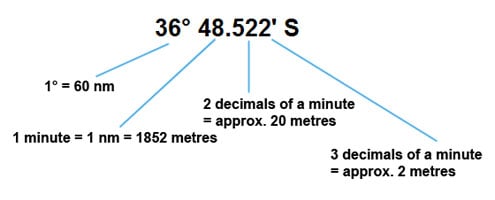Phillip Island Wreck Dives

Phillip Island in Victoria, Australia, has some awesome wreck dive sites for you to explore.
Coramba | Wreck Dive | Boat access |
| Latitude: 38° 32.116′ S (38.535267° S / 38° 32′ 6.96″ S) Longitude: 145° 8.800′ E (145.146667° E / 145° 8′ 48″ E) | ||
| Datum: WGS84 | Google Map | |
| Added: 2012-07-22 01:00:00 GMT, Last updated: 2022-04-27 00:42:09 GMT Source: GPS | ||
| Nearest Neighbour: Phelan Bluff, 2,284 m, bearing 6°, N | ||
| Twin Screw Steamer, 531 ton. Built: Ayrshire, Scotland, 1911. Launched: 15 August 1911. Sunk: 30 November 1934. Depth: 66 m. | ||
| See the Coramba dive site page | ||
George Kermode | Wreck Dive | Boat access |
| Latitude: 38° 31.230′ S (38.5205° S / 38° 31′ 13.8″ S) Longitude: 145° 14.687′ E (145.244783° E / 145° 14′ 41.22″ E) | ||
| Datum: WGS84 | Google Map | |
| Added: 2012-07-22 01:00:00 GMT, Last updated: 2022-04-29 06:05:14 GMT Source: GPS (verified) | ||
| Nearest Neighbour: Cunningham Bay, 1,442 m, bearing 342°, NNW | ||
| Twin Screw Steam Bucket Dredge. Built: Scotland, 1914. Sunk: 1 April 1976. Phillip Island, Bass Strait. Depth: 12 to 20 m. | ||
| See the George Kermode dive site page | ||
Minah | Wreck Dive | Boat access |
| Latitude: 38° 28.710′ S (38.4785° S / 38° 28′ 42.6″ S) Longitude: 145° 19.210′ E (145.320167° E / 145° 19′ 12.6″ E) | ||
| Datum: WGS84 | Google Map | |
| Added: 2012-07-22 01:00:00 GMT, Last updated: 2022-05-09 20:33:00 GMT Source: GPS | ||
| Nearest Neighbour: Surfies Point, 4,778 m, bearing 224°, SW | ||
| Iron Twin Screw Steam Tug. Built: 1900. Sunk: 1950. Rhyl, Western Port. Depth: 1 m. | ||
| See the Minah dive site page | ||
Vixen | Wreck Dive | Boat access |
| Latitude: 38° 26.700′ S (38.445° S / 38° 26′ 42″ S) Longitude: 145° 14.100′ E (145.235° E / 145° 14′ 6″ E) | ||
| Datum: WGS84 | Google Map | |
| Added: 2019-04-26 01:58:19 GMT, Last updated: 2022-05-16 00:17:03 GMT Source: Australasian Underwater Cultural Heritage Database (approximate location only) | ||
| Nearest Neighbour: Cowes Jetty, 454 m, bearing 107°, ESE | ||
| Twin Screw Steam Launch. Built: 1886, Lavender Bay, Sydney. Sunk: 20 July 1917. Cowes, Phillip Island, Western Port. Depth: 18 m. | ||
| See the Vixen dive site page | ||
[ Top ]
Heritage Warning: Any shipwreck or shipwreck relic that is 75 years or older is protected by legislation. Other items of maritime heritage 75 years or older are also protected by legislation. Activities such as digging for bottles, coins or other artefacts that involve the disturbance of archaeological sites may be in breach of the legislation, and penalties may apply. The legislation requires the mandatory reporting to Heritage Victoria as soon as practicable of any archaeological site that is identified. See Maritime heritage. Anyone with information about looting or stolen artefacts should call Heritage Victoria on (03) 7022 6390, or send an email to [email protected].
DISCLAIMER: No claim is made by The Scuba Doctor as to the accuracy of the dive site coordinates listed here. Should anyone decide to use these GPS marks to locate and dive on a site, they do so entirely at their own risk. Always verify against other sources.
The marks come from numerous sources including commercial operators, independent dive clubs, reference works, and active divers. Some are known to be accurate, while others may not be. Some GPS marks may even have come from maps using the AGD66 datum, and thus may need be converted to the WGS84 datum. To distinguish between the possible accuracy of the dive site marks, we've tried to give each mark a source, e.g. GPS, Google Earth, or unknown.
If you don't understand the differences between the different ways coordinates are given, plus how different datum come into play, you might find the article GPS Conversions by Lloyd Borrett a useful read. It describes the problems associated with locating dive sites using a GPS receiver.

Scuba Doctor Dive Map KML File
In the true spirit of making it easy to obtain, utilise and share the information for non-commercial purposes, you can now Download/view the Scuba Doctor Dive Map GPS Marks (KML file | 427.19 KB | 24-May-2022) in the Keyhole Markup Language (KML) file format used to display geographic data in an Earth browser such as Google Earth or Google Maps.
Some marine GPS units can import the information from a KML file. For others you can use use a file translate program (e.g. GPSBabel) to convert the KML file into an import file format (e.g. GPX) supported by your GPS unit.
Please Help Us To Correct GPS Marks and Add More Melbourne Dive Sites
If you have have information about other dive sites you'd be happy to see added to the information available here, or any corrections and/or updates to the diving site GPS marks listed here, please feel free to Contact Us. See also, Dive Site Help.
Copyright in photographs and other materials used here remains with their artists and authors. We are happy to acknowledge appropriate copyrights should they be made known to us.

